1940s
Cecil Jensen’s ELMO
I'm about thirty pages into this book, and can't recommend it highly enough. Pure hilarious surrealism.
Read a long article about the strip here.
Posted By: Paul - Wed Sep 11, 2019 -
Comments (0)
Category: Comics, Outsider Art, Surrealism, 1940s
The Lice-Infested Underwear Experiment
During World War II, millions of men served their country by fighting in the military. Hundreds of thousands of others worked in hospitals or factories. And thirty-two men did their part by wearing lice-infested underwear.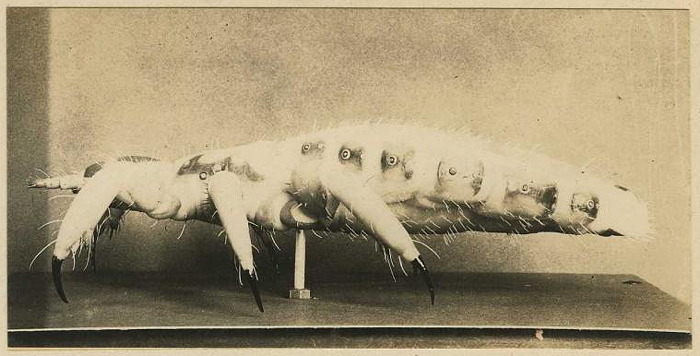
Model of a body louse, National Museum of Health and Medicine.
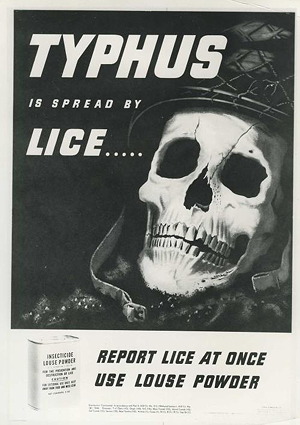
World War II public health warning
Source: Nat. Museum of Health & Medicine
In an attempt to prevent this, the Rockefeller Foundation, in collaboration with the federal government, funded the creation in 1942 of a Louse Lab whose purpose was to study the biology of the louse and to find an effective means of preventing infestation. The Lab, located in New York City, was headed by Dr. William A. Davis, a public health researcher, and Charles M. Wheeler, an entomologist.
The first task for the Louse Lab was to obtain a supply of lice. They achieved this by collecting lice off a patient in the alcoholic ward of Bellevue Hospital. Then they kept the lice alive by allowing them to feed on the arms of medical students (who had volunteered for the job). In this way, the lab soon had a colony of thousands of lice. They determined that the lice were free of disease since the med students didn't get sick.
Next they had to find human hosts willing to serve as subjects in experiments involving infestation in real-world conditions. For this they initially turned to homeless people living in the surrounding city, whom they paid $7 each in return for agreeing first to be infected by lice and next to test experimental anti-louse powders. Unfortunately, the homeless people proved to be uncooperative subjects who often didn't follow the instructions given to them. Frustrated, Davis and Wheeler began to search for other, more reliable subjects.
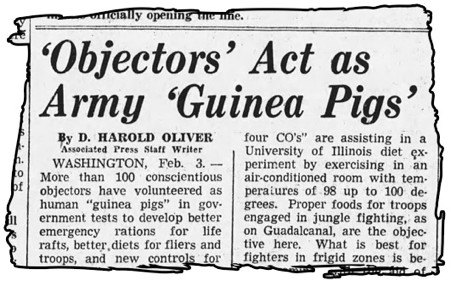
The Vancouver Sun - Feb 3, 1943
In theory, the COs were always given a choice about whether or not to serve as guinea pigs. In practice, it wasn't that simple. Controversy lingers about how voluntary their choice really was since their options were rather limited: be a guinea pig for science, or do back-breaking manual labor. But for their part, the COs have reported that they were often eager to volunteer for experiments. Sensitive to accusations that they were cowardly and unpatriotic, serving as a test subject offered the young men a chance to do something that seemed more heroic than manual labor.
Eventually COs participated in a wide variety of experiments, but Davis and Wheeler were the very first researchers to use American COs as experimental subjects. And they planned to infest these volunteers with lice.
More in extended >>
Posted By: Alex - Wed Sep 04, 2019 -
Comments (5)
Category: Health, Insects and Spiders, Experiments, Underwear, 1940s
The Tiger Woman
The Tiger Woman costume is made from Leopard fur. When outside, the natives are dressed as Navaho but, when inside, they are dressed as Aztecs. The chorus girl line, and their "harem-girl" costume, during an execution is frowned on. The men in the serial do not remove their hats whether inside or out.[5] However, in South America "Tiger" refers to any big cat.
The Wikipedia page.
Posted By: Paul - Sun Aug 25, 2019 -
Comments (2)
Category: Animals, Ineptness, Crudity, Talentlessness, Kitsch, and Bad Art, Movies, 1940s
Mad Mouse/Wild Mouse Roller Coaster
This old-school ride looks scarier than the new ones, because tinier and more vulnerable.The history of the ride.
Order yours here!

Posted By: Paul - Fri Aug 16, 2019 -
Comments (3)
Category: Animals, Daredevils, Stuntpeople and Thrillseekers, Fairs, Amusement Parks, and Resorts, 1940s, 1950s
Project Capricious
During World War II, the OSS (precursor to the CIA) hatched a plan to defeat General Rommel's Afrika Korps by using synthetic goat poop. The idea was to drop huge amounts of pathogen-laced pseudo-poop over African towns. Local insects would be attracted to the stuff and would then carry the pathogens to Rommel's troops. However, before the plan could be carried out, Rommel's troops were withdrawn from the area and sent to Russia.Jeffrey Lockwood tells the story in more detail in his book Six-Legged Soldiers: Using Insects as Weapons of War.
The plan was to weaken the enemy forces by using flies to spread a witch's brew of pathogens. Given the agency's inability to rear an army of flies, [OSS Research Director] Lovell decided to conscript the local vectors...
Lovell was a chemist, but he'd been out of the laboratory often enough to know that flies love dung. And with a bit of research, he discovered a key demographic fact: There were more goats than people in Morocco — and goat are prolific producers of poop. Lovell now had the secret formula: microbes + feces + flies = sick Germans. Now all he needed was a few tons of goat droppings as a carrier for laboratory-cultured pathogens.
The OSS collaborated closely with the Canadian entomological warfare experts to launch one of the more preposterous innovations in the history of clandestine weaponry: synthetic goat dung. Of course flies are no fools; they won't be taken in by any old brown lump. So the OSS team added a chemical attractant. The nature of this lure is not clear, but a bit of sleuthing provides some clues.
Allied scientists might have crafted a chemical dinner bell by collecting and concentrating the stinky chemicals that we associate with human feces (indole and the appropriately named skatole). While these extracts would have worked, the more likely attractant was a blend of organic acids, some of which had been known for 150 years. Two of the smelliest of these are caproic and caprylic acids, which, by no coincidence, derive their names from caprinus, meaning "goat." Etymologically as well as entomologically astute, Lovell named the operation Project Capricious. So with a scent to entice the flies, Lovell's team then coated the rubbery pellets in bacteria to complete the lures.
All the Americans had to do was drop loads of pathogenic pseudo-poop over towns and villages where the Germans were garrisoned, and millions of local flies would be drawn to the bait, pick up a dose of microbes, and then dutifully deliver the bacteria to the enemy. Lovell worried about keeping the operation clandestine. The Moroccans had to be persuaded that finding goat droppings on their roofs the morning after Allied aircraft flew over was a sheer coincidence. Presumably a good disinformation campaign can dispel almost any suspicion, or, as Lovell intimated, if the plan succeeded there would be very few people in any condition to raise annoying questions about fecal pellets on rooftops...
In the end, however, Lovell didn't have to worry about getting caught by either friends or foes, as the secret weapon was never deployed. Just as the OSS was gearing up to launch the sneak attack, the German troops were withdrawn from Spanish Morocco. They might well have preferred to take their chances with pathogen-laden flies, given that Hitler was sending them to the bloody siege of Stalingrad.
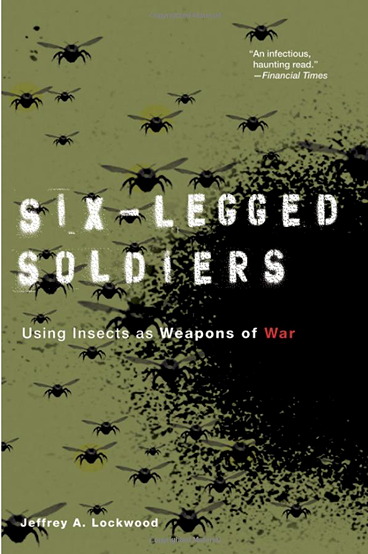
Posted By: Alex - Sat Jul 20, 2019 -
Comments (5)
Category: Insects and Spiders, Military, War, Weapons, Excrement, 1940s
The Readinjack
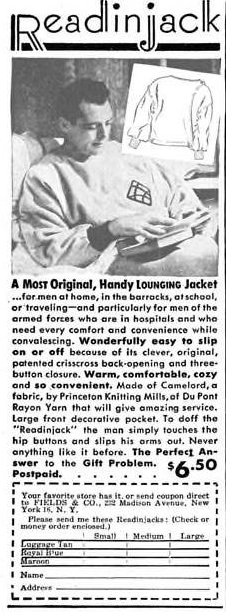
The ad copy is unique.
Source.
Posted By: Paul - Tue Jul 02, 2019 -
Comments (3)
Category: Fashion, Advertising, Chindogu, 1940s
Mystery Gadget 74
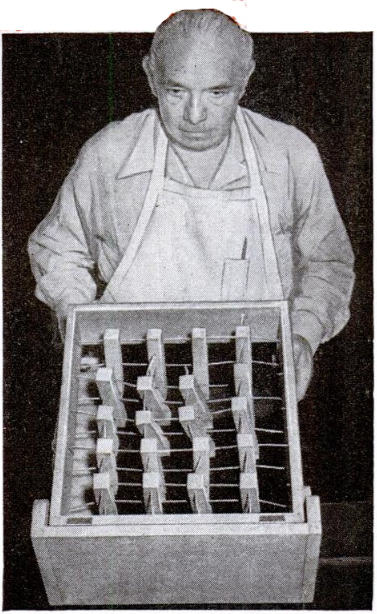
The purpose of this simple gadget?
The answer is here.
Or after the jump.
More in extended >>
Posted By: Paul - Sun May 12, 2019 -
Comments (3)
Category: Technology, 1940s
Follies of the Madmen #424
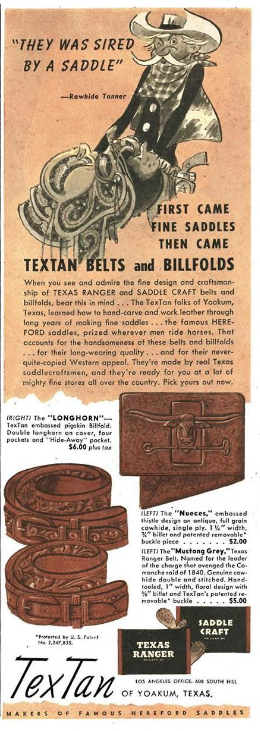
This ad raises the intriguing question: "What female thing did the saddle screw to produce the wallet?"
Source.
Posted By: Paul - Sat May 11, 2019 -
Comments (3)
Category: Anthropomorphism, Business, Advertising, Sexuality, 1940s
My Clam Digger Sweetheart
Posted By: Paul - Wed May 01, 2019 -
Comments (1)
Category: Humor, Music, Oceans and Maritime Pursuits, 1940s, Love & Romance
Donut Prune Salad
“Place two donuts on a lettuce leaf, fill the donut centers with cottage cheese and then top each donut with a stuffed prune. Place two whole pitted prunes beside the donuts. Serve with mayonnaise.”Source: 36 Delightful Recipes to Perk Up Your Meals, published by the Doughnut Corporation of America, 1947.
via Vintage Bug

Posted By: Alex - Sun Apr 28, 2019 -
Comments (4)
Category: Food, 1940s

| Who We Are |
|---|
| Alex Boese Alex is the creator and curator of the Museum of Hoaxes. He's also the author of various weird, non-fiction, science-themed books such as Elephants on Acid and Psychedelic Apes. Paul Di Filippo Paul has been paid to put weird ideas into fictional form for over thirty years, in his career as a noted science fiction writer. He has recently begun blogging on many curious topics with three fellow writers at The Inferior 4+1. Contact Us |




